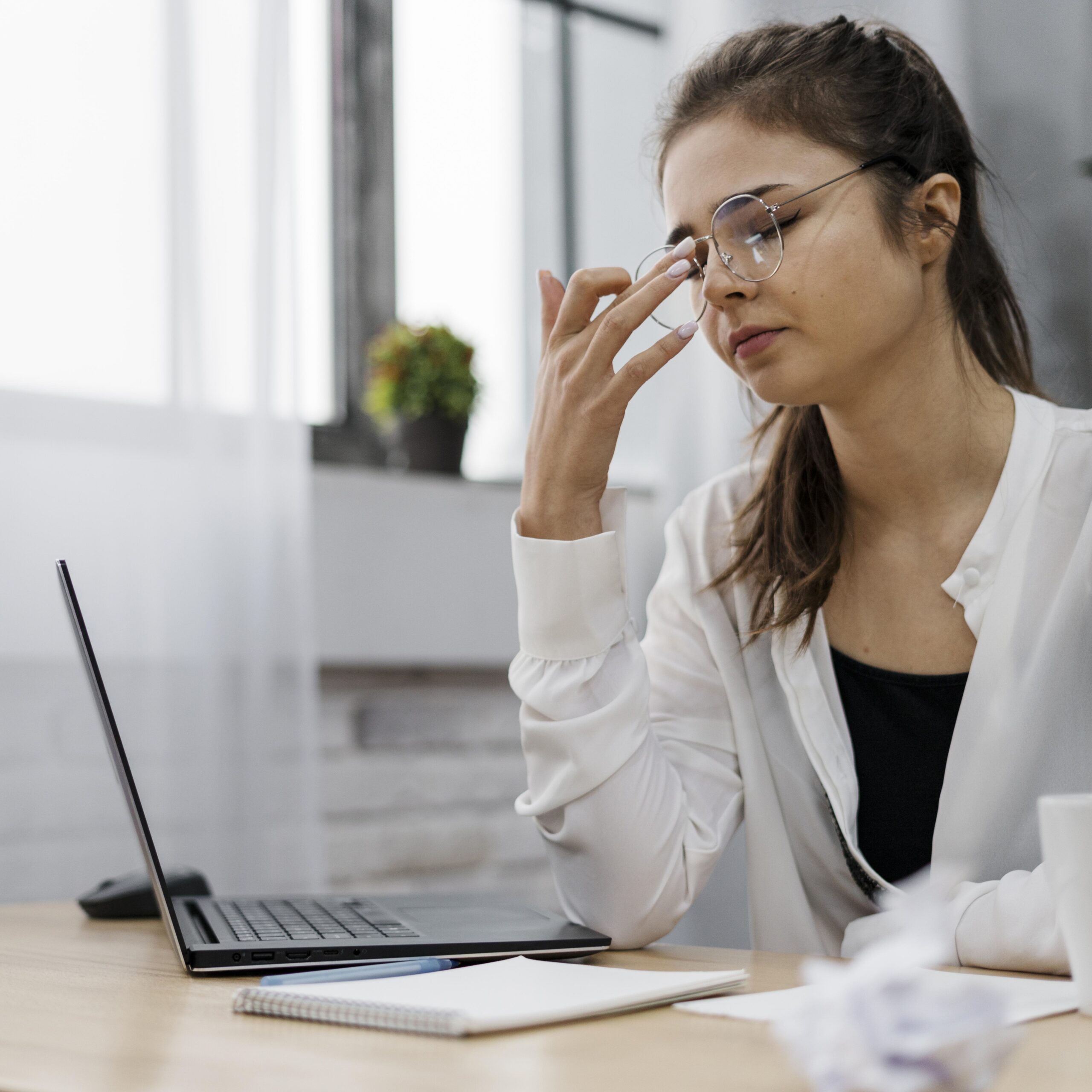Protect Your Eyes from Digital Eye Strain
In today’s digital world, many of us spend hours each day looking at screens—whether it’s for work, school, or leisure. While technology has transformed how we live and communicate, it has also introduced new challenges to our eye health. One of the most common concerns is digital eye strain, also known as computer vision syndrome. At Victoria Village Optometry, we believe that prevention and awareness are essential for maintaining long-term eye comfort and clarity.
What Is Digital Eye Strain?
Digital eye strain refers to a group of vision-related symptoms that result from prolonged use of digital screens, including computers, tablets, smartphones, and televisions. Common symptoms include: Eye fatigue or discomfort Dry or watery eyes Blurred or double vision Headaches Neck and shoulder pain These symptoms can develop after just two hours of continuous screen use, making it a significant concern for students, professionals, and anyone regularly exposed to digital devices.
Why Screens Affect Eye Health
Digital screens differ from printed material in a few key ways that make them more taxing on the eyes:
Reduced Blink Rate: When focusing on screens, people tend to blink less often, which leads to dry eyes and discomfort.
Blue Light Exposure: Screens emit high-energy visible (HEV) blue light, which can disrupt sleep patterns and contribute to visual fatigue.
Poor Ergonomics: Unadjusted screen positions or incorrect viewing distances can force the eyes and body into unnatural positions, contributing to both visual and musculoskeletal strain.
Understanding these factors is the first step toward protecting your vision.
Limit Screen Time and Take Breaks
The 20-20-20 rule is a widely recommended method to reduce digital eye fatigue:
Every 20 minutes, look at something 20 feet away for at least 20 seconds. This simple practice allows your eye muscles to relax and reset.
Additionally, try to schedule screen-free time throughout your day, particularly before bedtime. Reducing overall screen time can minimize the accumulation of eye strain over time.
Adjust Your Environment and Ergonomics
Proper workstation setup plays a critical role in ergonomic eye care:
- Screen Position: Keep the screen about 20 to 28 inches from your eyes and slightly below eye level.
- Lighting: Avoid glare by using blinds or curtains, and position your screen to minimize reflections from windows or overhead lighting.
- Text Size and Contrast: Make sure text is large enough to read comfortably, and choose high-contrast settings for better clarity.
Ergonomic adjustments can not only improve comfort but also reduce neck, shoulder, and back pain associated with poor posture during screen use.
Use Blue Light Blocking Glasses
Blue light blocking glasses are specially designed to filter out high-energy blue light from digital screens. While blue light is naturally present in sunlight, excessive artificial exposure—especially in the evening—may interfere with melatonin production and disrupt sleep.
Patients who wear blue light filtering lenses often report reduced glare, improved visual comfort, and fewer headaches. These lenses are especially helpful for those who work extended hours in front of a computer or experience frequent screen-related fatigue.
Keep Your Eyes Moisturized
Dry eyes are one of the most common symptoms of computer vision syndrome. To combat this, you can:
- Use preservative-free artificial tears
- Position fans or vents away from your face
- Blink frequently and fully
- Use a humidifier in dry environments
During an eye exam, our optometrists can assess tear quality and recommend personalized solutions to improve eye comfort.
Schedule Regular Eye Exams
Many vision problems related to screen use are due to uncorrected refractive errors or outdated prescriptions. At Victoria Village Optometry, we offer comprehensive eye exams that assess more than just your ability to see clearly—we evaluate how your eyes work together, your focusing ability, and overall eye health.
If you’re experiencing symptoms of digital eye strain, it’s important to rule out underlying conditions like astigmatism, presbyopia, or binocular vision dysfunction, all of which can be exacerbated by screen use.
Consider Specialized Lenses or Coatings
In addition to blue light filters, you may benefit from other lens technologies tailored to your screen usage:
- Anti-reflective (AR) coatings to reduce glare
- Photochromic lenses that adjust to light conditions
- Occupational lenses with intermediate and near-distance optimization for office work
During your consultation, we’ll help you choose lenses that support your unique visual demands and lifestyle.
Frequently Asked Questions
What is the difference between digital eye strain and regular eye fatigue?
Digital eye strain is a specific form of visual fatigue caused by prolonged use of digital screens. While regular eye fatigue can result from various tasks like reading or driving, digital eye strain is characterized by symptoms such as dry eyes, blurry vision, and headaches associated with electronic device usage.
Are blue light blocking glasses suitable for everyone?
Yes, blue light blocking glasses can be beneficial for most people who spend significant time in front of screens. They are especially useful in the evening when blue light exposure can interfere with sleep. However, they should be seen as part of a broader strategy that includes ergonomic practices and regular breaks.
How often should I have an eye exam if I use screens daily?
We recommend a comprehensive eye exam at least once every two years, or more frequently if you experience symptoms of computer vision syndrome. Children, seniors, and individuals with existing eye conditions may require more regular monitoring.
Can children experience digital eye strain?
Absolutely. With the rise in remote learning and digital entertainment, children are increasingly affected by screen time and eye health concerns. Encourage kids to follow the 20-20-20 rule, limit recreational screen use, and bring them in for routine eye exams to detect early signs of strain or vision issues.
Conclusion
Digital eye strain is an increasingly common issue as screens play a larger role in both our professional and personal lives. Fortunately, there are effective strategies to protect your eyes—from wearing blue light blocking glasses and following the 20-20-20 rule to making ergonomic adjustments and keeping your eyes hydrated.
At Victoria Village Optometry, we are dedicated to supporting your eye health in the digital age. If you’re experiencing symptoms of computer vision syndrome or have concerns about your screen time habits, we encourage you to book a comprehensive eye exam. A proactive approach today can make all the difference for your long-term visual comfort.










